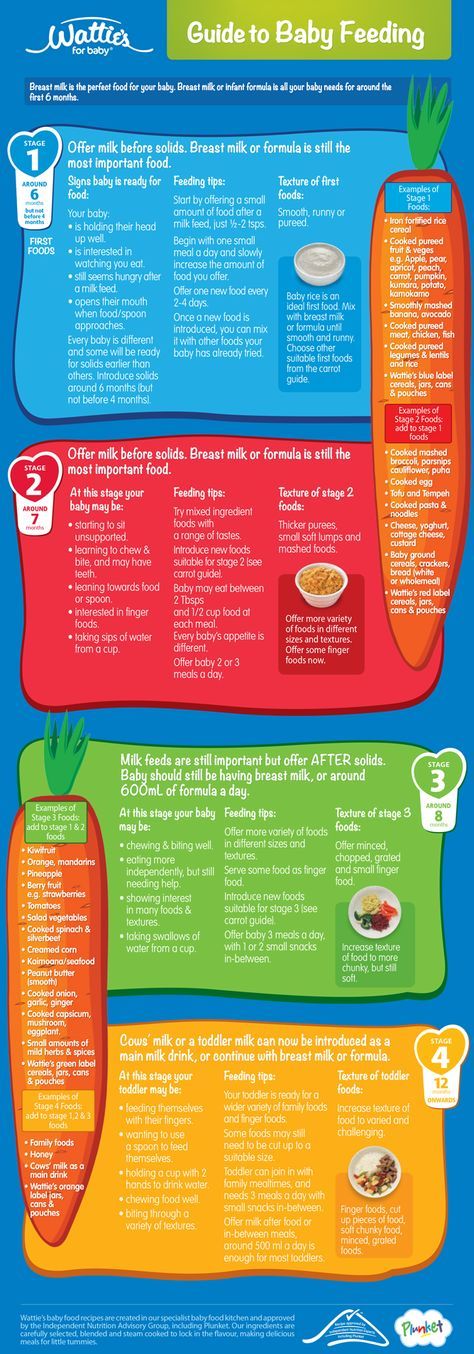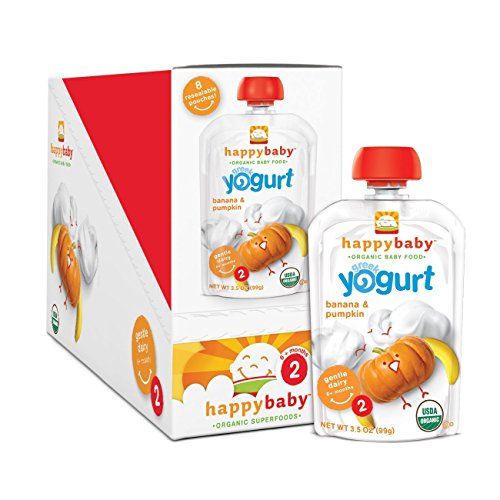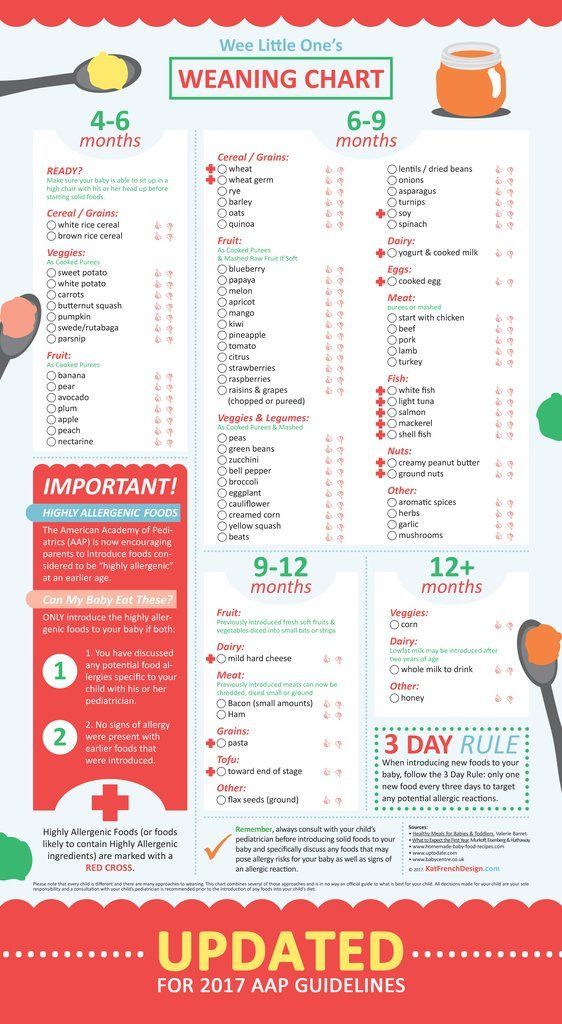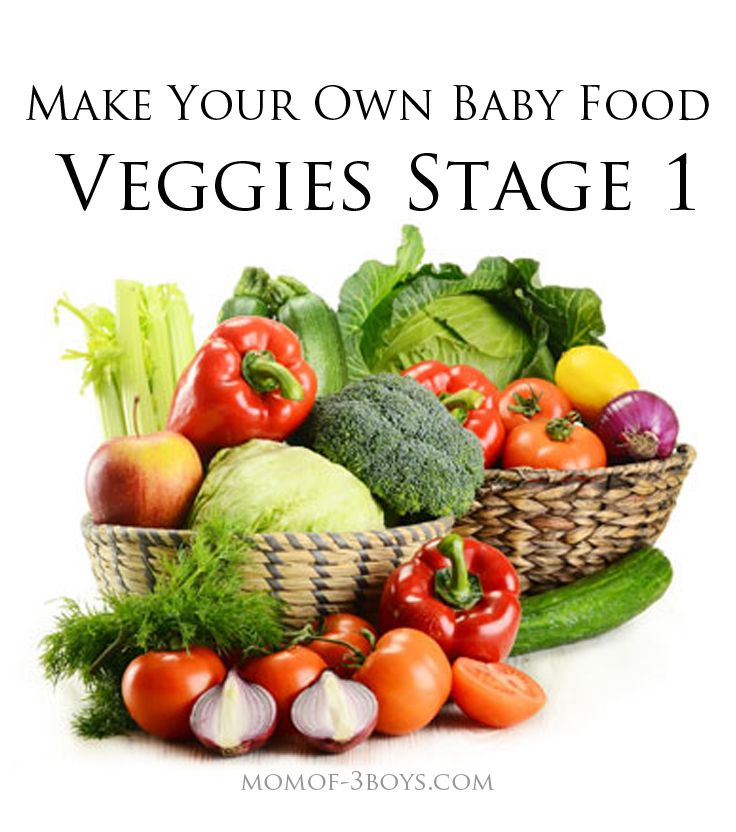Stage three baby foods
When is a child ready to try thicker solids?
Your baby’s made it through cereal mush, soupy carrots and ever-so-slightly texturized chicken and squash dinners. Now it’s time for the real culinary fun to start — welcome to Stage 3 baby food!
“Once your baby has successfully eaten Stage 2 foods, which have some texture to them, they can start Stage 3,” says Dr. Melanie Custer, a pediatrician at West Bend Pediatrics, Children’s Wisconsin.
How do you know your baby is ready to make the leap from purees to slightly more sophisticated fare? Here, experts and parents weigh in on moving on to Stage 3 baby food. Time to dig in!
What is Stage 3 baby food?
Most jars of Stage 3 baby food are still pretty pureed (hence, the jars), but your little one needn’t be restricted solely to foods that are, for all intents and purposes, mush. Instead, you can steer your budding gourmand toward soft, small pieces of whatever you’re having. Think: cut-up pieces of turkey meatballs, banana chunks and small squares of tofu.
“Stage 3 baby foods are thick blended foods with chewable chunks, such as the kind you find at the grocery store, or small cut-up pieces of easily chewed table foods, which are usually referred to as ‘finger foods’,” says Dr. Kristen Treegoob, a pediatrician at Children’s Hospital of Philadelphia. (Avoid placing chunks of food in blends and purees, as it may cause a choking risk.)
“Stage 3 baby foods are thick blended foods with chewable chunks, such as the kind you find at the grocery store, or small cut-up pieces of easily chewed table foods, which are usually referred to as ‘finger foods.'”
DR. KRISTEN TREEGOOB, PEDIATRICIAN
And be sure to bear in mind that every child is different and develops at their own individual pace. Check with your child’s doctor for baby food recommendations during the first year.
When to start Stage 3 baby food
“Typically, 9 months is the age babies start eating Stage 3 foods,” says Dr. Zulma Laracuente, a pediatrician in Alexandria, Louisiana. “But, generally-speaking, 9 to 12 months is considered a time of slowly transitioning your baby to table food.” (In other words, no more cooking and serving separate meals!)
“But, generally-speaking, 9 to 12 months is considered a time of slowly transitioning your baby to table food.” (In other words, no more cooking and serving separate meals!)
Does that mean you baby is ready to tuck into a T-bone steak with a side of broccoli rabe? No. At least, not in the traditional form. But as long as food is small and very easy for baby to work through, it’s OK.
While the idea of having your 10-month-old feed themselves while you sit down to your own meal probably sounds heavenly, bear in mind, every child gets there in their own time.
“My first child couldn’t wait to eat mashed up meatballs and soft carrots on his own,” says mom of two Jennifer Reilly of New York City. “But my second? Not so much. Aside from puffs, I was still spoon-feeding him at nearly a year!”
Signs baby is ready to start Stage 3 or finger food
As your baby’s oral skills and hand-eye coordination develop, they’re moving closer to being able to feed themselves, either with their hands or a spoon. (Though, according to the Cleveland Clinic, babies usually don’t get the hang of utensils until at least 12 months.)
(Though, according to the Cleveland Clinic, babies usually don’t get the hang of utensils until at least 12 months.)
According to Jenifer Thompson, R.D., an advanced practice dietician at Johns Hopkins in Baltimore, babies can move past traditional baby foods and onto “pick-ups” (finger foods) as their pincer grasp skills are honed.
“By the time baby is between 8 to 12 months old, they should be able to pick up small, soft pieces of finger foods with their finger and thumb and bring them to their mouth,” she says.
Other signs your baby is ready to take meal time into their own hands? They tell you — as only a baby can.
“I knew my son was ready to try table foods when he started grabbing at the spoon every time I went to feed him,” says mom of two Darcy McConnell of Garwood, New Jersey. “Even though he didn’t actually use a fork or spoon for a few months, he loved holding on to them while he picked up his food. It was so cute!”
What Stage 3 foods to start with
Once you’ve hit the Stage 3 phase, (almost) anything goes, as long as it’s the right texture for baby. For instance, it’s OK to feed your child what the rest of the family is having for dinner, as long as you take proper precautions, such as making sure food is easy to chew and cut up into small pieces.
For instance, it’s OK to feed your child what the rest of the family is having for dinner, as long as you take proper precautions, such as making sure food is easy to chew and cut up into small pieces.
“Once babies are about 9 months old, they should safely be able to self-feed a variety of foods,” says Treegoob.
At this point in your baby’s life, solid food is starting to make up a significant part of their diet, so it’s important to offer foods that are nutritious. Also, exposing your child to different foods that are nourishing from an early age can help lay the groundwork for good, long-term habits.
“Parents should introduce a variety of healthy foods from different food groups with different textures by the end of the first year in order to help with healthy eating habits,” says Thompson.
“Parents should introduce a variety of healthy foods from different food groups with different textures by the end of the first year in order to help with healthy eating habits.
jenifer thompson, advanced practice dietician”
Here are a few good choices for Stage 3 foods, according to Thompson and Treegoob:
- Well-cooked vegetables of any variety.
- Ripe fruits of any variety. (Mashed or cut-up bananas work very well at this stage.)
- Shredded meat.
- Scrambled eggs.
- Soft cheese.
- Cooked pasta.
- Small pieces of tofu.
Which foods to avoid during Stage 3
When your baby starts eating what the rest of the family is having, by all means, rejoice over having to prepare fewer dishes. However, if you’re hitting up the drive-thru after soccer practice with your older kid, skip the Happy Meal for your baby, regardless of how you serve it.
“When it comes to feeding babies, I recommend avoiding heavily salted or sweetened foods, as well as fast food,” says Treegoob.
The reason doctors advise being mindful of baby’s salt intake? In addition to it possibly contributing to bad eating habits overall, a 2011 study published in the European Journal of Clinical Nutrition found that infants who consumed over 400 milligrams of sodium per day (the maximum UK recommendation for children up to age 12 months) were potentially at risk of “harming developing kidneys” and causing “high blood pressure in later life. ”
”
According to Treegoob, parents should also avoid any foods that may pose a choking risk to children, such as:
- Popcorn.
- Whole grapes.
- Whole peanuts.
- Raisins.
- Hot dogs.
- Hard candy.
- Seeds.
And finally, parents and caregivers should understand how long baby foods last and forgo giving a baby honey until after their 1st birthday, as it can cause a botulism infection.
How to start Stage 3 foods safely
As with Stage 1 and Stage 2 baby food, babies still should eat sitting upright with an adult nearby.
“Once an infant is ready for Stage 3 solids and is able to finger feed themselves, it’s still important to watch your baby eat, so you can help pace them and identify signs of choking early,” says Treegoob. “You can also offer them sips of formula, breast milk or a little water every few bites when they begin eating more than a few ounces at a time of Stage 3 foods to make sure they don’t eat too quickly. ”
”
“Once an infant is ready for Stage 3 solids and is able to finger feed themselves, it’s still important to watch your baby eat, so you can help pace them and identify signs of choking early.”
DR. KRISTEN TREEGOOB, PEDIATRICIAN
Also, be sure the food you’re giving your baby is prepared for their developmental stage. According to Kids Health, parents should slice food up into small pieces in addition to cooking it a little longer in order to make sure it’s very soft. (And, of course, check the temperature!)
Once your baby gets a taste of “real food,” don’t be surprised if their interest in formula or breast milk wanes.
“Between 7 to 9 months, parents may notice that their baby shows interest in smaller or less frequent bottles or breastfeeds,” says Treegoob. “As long as weight remains on track and the baby is staying hydrated, there’s no cause for concern.”
According to Treegoob, babies between 4 to 6 months old typically drink between 24 to 40 ounces of breast milk or formula per day; 24 to 32 ounces from 6 to 9 months; and by 9 to 12 months, when they’re eating more table foods, that volume can decrease to as low as 16 to 24 ounces.
The American Academy of Pediatrics recommends giving baby between 4 to 6 ounces of breast milk or formula four times a day, along with three meals a day and two small snacks. What you give your little one is up to you — just make sure it’s healthy and texturally appropriate for their age.
Make Your Own Stage 3 Baby Foods
Starting around eight months old, your baby is likely eager to try new tastes and textures every day as they develop new motor skills and get more experience with eating. At Beech-Nut, we love seeing how babies transition from smooth purees to the new consistencies and combos of stage 3 foods, but we know stage 3 blends can be hard to find in your local grocery store. So, here are some tips on how to repurpose stage 2 blends to add new textures and more protein for a growing baby.
Repurpose Stage 2 Purees
Mix in whole grains: Until now, your baby has likely only tasted smooth purees. As he or she ages, it’s important to diversify the consistency of their meals. Mix in heartier textures such as quinoa, barley, or oats to Beech-Nut jars to add a grainy toothsomeness to baby’s meals. Overnight oats are one of our favorite breakfast options, because it’s so quick and easy! Check out our pumpkin spice overnight oats recipe here.
As he or she ages, it’s important to diversify the consistency of their meals. Mix in heartier textures such as quinoa, barley, or oats to Beech-Nut jars to add a grainy toothsomeness to baby’s meals. Overnight oats are one of our favorite breakfast options, because it’s so quick and easy! Check out our pumpkin spice overnight oats recipe here.
Try pasta: One of the most common introductory foods for babies is bite-sized pasta pieces, as long as baby is able to chew on his own. Since you probably already have pasta in your kitchen, this is a quick and convenient way to add some texture to baby’s diet. As your baby begins to embrace these foods, try this recipe from our Registered Dietitian Nutritionist Eileen for an easy-to-make, healthy spaghetti sauce using Beech-Nut vegetable purees like green beans or sweet potatoes!
Mash lentils, chickpeas & beans: Adding mashed lentils, chickpeas, and beans is a common way to thicken up soups, but they’re also perfect for thickening your favorite purees! Try adding these to any Beech-Nut jar for a meal complete with calcium, iron, and fiber.
Introduce protein: Your baby may be getting protein in their diet from milk, but this is a great time to add other protein sources. Try adding small, shredded pieces of any of these to one of our Naturals or Organics jars for a wholesome dinner in a jar! Turkey and sweet potatoes is one of our favorites.
- Lean red meat, poultry (chicken, turkey) or fish (make sure your baby doesn’t have an allergy)
- Well-cooked eggs (yolk and white)
- Full fat cottage cheese
- Whole-milk yogurt (avoid yogurts with artificial sweeteners)
Add purees to your favorite recipes: Our purees aren’t just for babies—these snacks will have your whole family wanting more. Add your favorite flavors to soft foods your baby can enjoy, like muffins or pancakes cut into small bites. For an easy recipe, check out some yummy mango puree pancakes our Pediatric Nutrition Expert Nicole here.
Add your favorite flavors to soft foods your baby can enjoy, like muffins or pancakes cut into small bites. For an easy recipe, check out some yummy mango puree pancakes our Pediatric Nutrition Expert Nicole here.
Let Baby Self-Feed
Try dissolvable snacks: Babies who like feeding themselves will love Beech-Nut Melties. Our Melties are designed to help baby practice fine motor skills, while being easily dissolvable to minimize choking hazards. As your child grows, add pretzel pieces and dried fruit for a healthy trail mix! See a list of Beech-Nut Melties here.
Get Creative!
Be the chef—create your own combos: We love seeing what innovative fruit & veggie mixes we can come up with. Chop or mash your own favorite fruits & veggies and add them to our Beech-Nut purees to introduce new combinations and textures to baby. Make sure to let us know what you come up with. Some ideas: chickpeas, lentils, or other baby-friendly leftovers from your family meal.
Some ideas: chickpeas, lentils, or other baby-friendly leftovers from your family meal.
Make a frozen treat: Frozen purees are great for snacks and can also help soothe a teething baby. For help preparing your own, check out this frozen puree teething heart recipe from BabyFoodE here.
Let us know your favorite meal ideas by finding us on Facebook or Instagram. We’d love to hear from you!
*Always check with your pediatrician before introducing new foods to your baby’s diet
8-10 months - Encyclopedia Baby food
Stage 3 - 8-10 months
Levchuk Victoria ©8-10 months - time to study!
Third stage: 8-10 months
The third stage of baby food 8-10 months is a term that refers to baby food, meaning a thicker and more textured section. This stage of baby food also includes the ingredients that the child has been eating for the last 7-8 months.
Some parents define the third stage of baby feeding as the shortest. Foods during this period should be appropriate for the age of the infant who is beginning to learn to "chew" foods and who have completely lost the tongue thrust reflex. Ready-made baby food of the third stage is aimed at children who are aged from 8-10 to 12 months.
The baby has grown up, teeth have appeared, motor activity has increased, it is already possible to introduce food with a thicker consistency with the presence of pieces of different sizes, but not very large. Now the main thing is to help the baby learn to chew and overcome small pieces of food. At this stage, the baby is able to take small pieces of food with his hands and direct them almost exactly into his mouth, then chew it all, the mother should encourage the development of these skills. Therefore, the mother offers the baby finger food: unsweetened cookies, apple slices, pieces of cheese or boiled carrots.
Breastfeeding continues on demand, but it is already possible to give the baby to drink from a cup, of course the best drink is water, but you can also offer compote or yogurt. Breastfed babies may refuse extra fluids, but don't worry. When feeding on demand, the baby receives enough liquid, at this stage it is important for the mother to provide a choice for the baby.
Breastfed babies may refuse extra fluids, but don't worry. When feeding on demand, the baby receives enough liquid, at this stage it is important for the mother to provide a choice for the baby.
Your baby's diet should be varied. Vegetables are boiled until soft, and boiled meat passes through a meat grinder, and then only warms up. Variety includes vegetables, meat, fruits, legumes, a small amount of fish, kefir, eggs (although you can postpone the entry to a later period), cheese, liver.
Be sure to boil the eggs thoroughly and never offer raw eggs in any form, so as not to become infected with salmonella. The main thing at every meal is to offer the child finger food, for example, pieces of carrots, pears, toasted bread with a piece of butter. Remember that sugar and salt are still not recommended! A breastfed child has three meals a day, while artificial children have five meals a day. Between main meals, you can give your baby light snacks yogurt, apple, kefir, bread in small quantities.
The third stage of baby food includes products that still have the lowest index on the allergy scale, but some dairy products and wheat products are introduced at this stage. As a rule, during this period, those foods that are more fibrous, slightly more acidic and contain more protein are introduced. These products should be well tolerated and absorbed by the child.
Also during this period, most parents introduce some spices, raw fruits and pasta.
Remember that babies don't have molars until 14-18 months, so foods should be mashed with small chunks of structured food and easily pass between the gums.
Social networks:
Union of pediatricians of Russia
Home> Information for Parents> Parents> Foods from 1 year to 3 years old
Feeding children aged 1 to 3 years
The period from 1 to 3 years of life is a crucial stage in the transition to an adult type of nutrition, which has certain features. In order to ensure that all the necessary nutrients enter the child's body and at the same time prevent an excess of individual nutrients, nutrition should be balanced and varied.
In order to ensure that all the necessary nutrients enter the child's body and at the same time prevent an excess of individual nutrients, nutrition should be balanced and varied.
The daily amount of food for children aged 1 to 1.5 years should be 1000-1200 g, from 1.5 to 3 years - 1200-1500 g, the amount of food in one feeding should not exceed 300-350 ml. The diet consists of three main meals per day and two snacks. It is considered optimal when breakfast is 25% of the total energy density of the diet, lunch is 30–35%, dinner is 20%, and additional meals are about 10%. In general, the child can eat the same food as the rest of the family.
In the diet of a child of 1–3 years of age , must be present daily: meat of animals or poultry, dairy and sour-milk products, vegetables, fruits, bread, cereals, vegetable and butter; fish and eggs are included in the diet 2-3 times a week.
Cereal products: bread - 2-3 servings per day, cereals and side dishes - 1 time per day
Fruit and/or vegetables: at least 5 times a day
Dairy products: at least 3 servings per day (including those used to make cereals, yoghurts, fermented milk drinks, cottage cheese, infant formula or breast milk).
Domestic pediatricians recommend, when compiling a diet for children aged 1–3 years, preference should be given to specialized children's dairy products of industrial production that meet high quality requirements and safety indicators for this age. Most children's dairy products are additionally enriched with vitamins and/or minerals and other biologically active components, taking into account the physiological needs of children of this age. At the same time, in foreign recommendations, children over 1 year old are offered the gradual introduction of whole cow's milk, which is rich in fats necessary for proper growth and development, the absorption of vitamins A and D, the development of the child's brain and nervous system.
Meat dishes: 2-3 meals per day
Fish dishes: 2-3 servings per week
Eggs: 2-3 per week
Dietary fats: 3-4 teaspoons of butter and/or vegetable oil oils per day
When cooking, use the minimum amount of salt and sugar, and do not add them to industrial products.











